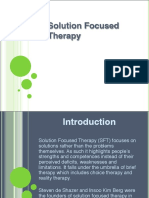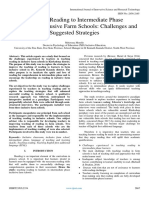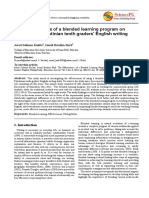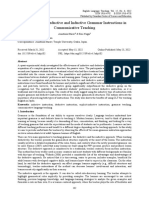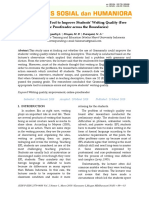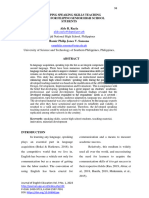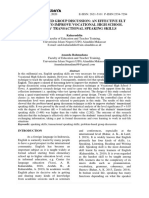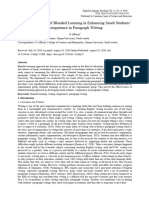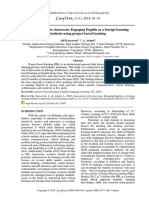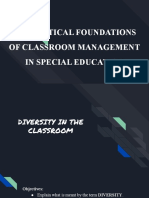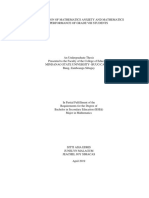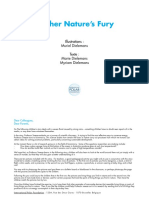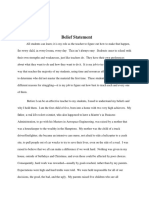Professional Documents
Culture Documents
Problem-Based Instructional Approach As A Determinant of English Writing Performance of PreService Technical Teachers in South-Western, Nigeria
Original Title
Copyright
Available Formats
Share this document
Did you find this document useful?
Is this content inappropriate?
Report this DocumentCopyright:
Available Formats
Problem-Based Instructional Approach As A Determinant of English Writing Performance of PreService Technical Teachers in South-Western, Nigeria
Copyright:
Available Formats
Volume 7, Issue 3, March – 2022 International Journal of Innovative Science and Research Technology
ISSN No:-2456-2165
Problem-Based Instructional Approach as a
Determinant of English Writing Performance of Pre-
Service Technical Teachers in South-Western,
Nigeria
Olowoyeye C. A.
Department of General Studies, School of Multidisciplinary Studies,
Bamidele Olumilua University of Education, Science and Technology
Abstract:- This study examined the Problem-based by the National Commission for Colleges of Education,
Instructional Approach as a determinant of the English among other things, is to enable the students to acquire
writing performance of pre-service technical teachers in proficiency in the use of the language for effective
South-western Nigeria. The objectives of this study were communication.
to: (i) examine the general level of English writing
performance of the pre-service technical teachers (ii) General English courses are taken as a five-semester
assess the English writing performance of pre-service course. The aspects covered include grammar, reading,
technical teachers exposed to PBIA. A quasi-experimental listening, speech, study skills, vocabulary and writing.
study with pre-test, post-test, non-randomised and non- Writing is quite pertinent for the productive and expressive
equivalent control group design was adopted. The communication of teachers and learners alike. Teachers, as
population consisted of 983 college of education students models and locus of knowledge, need to be well-grounded in
in South-Western Nigeria. A multi-stage sampling the art of writing. Among the language skills, writing is the
technique was employed to select the respondents for the most enervating and perhaps the most instructive. It brings
study. The data were analysed using the percentage, out exactitude in such a way that other skills do not. Writing
mean, standard deviation, t-test and analysis of co- is also of various kinds, its major determinant being the
variance at 0.05 level of significance. The findings of the audience, subject matter and the purpose of writing
study were that: the general level of English writing (Adedimeji, 2009). Writing makes practical application and
performance was relatively low before the treatments utilisation of all other language skills and language
(control group, 32.59:30.61) but high after the treatments components expressively.
(48.26; 46.62); there was no significant difference in the
English writing performance of pre-service technical Students need to be supported as self-directed,
teachers taught through PBIA and control (F 1.353= 439 autonomous learners to provide learning opportunities
P>0.05). The study concluded that the PBIA approach is (Zainuddin, Habiburrahim, Muluk, & Keumala, 2019). There
highly needed in the teaching of writing. The study is the need to employ instructional strategies that will enhance
recommended that teachers should employ the use of independent and collaborative learning opportunities, such as
PBIA for teaching writing to enhance students’ Problem-based Instructional approach, etc. The Problem-
performance. based Instructional method is a learner-centred, inquiry-based
instructional style in which learners interact with a genuine,
Keywords:- English Writing Performance, Problem-Based poorly organised problem that needs further study (Decker-
Instructional Approach, Pre-Service, Technical Teacher, Lange, 2018). Problems-based instruction (PBI) gives the
Cognitive Learning. possibility to self-directed learning, collaborative learning,
meta-cognitive and creative problem-solving capabilities to
I. INTRODUCTION change the world quickly. Classroom studies in higher
education strongly impact students’ skills from a Problem-
The English language has become an indispensable tool Based Instruction (PBI) (Diningrat, Setyosari, Ulfa, &
in every stratum of social interaction worldwide. The Widiati, 2020).
teaching and learning of English as a second language
(ESL) have been deeply entrenched in the national The 21st century of learning requires learning skills,
curriculum at all levels of education in Nigeria. In tertiary methods and resources, which learners may use after leaving
institutions, the English language is taught within the General school (Weeks, 2019). The PBI is found to equip students
Studies Programme. In universities, it is taught as Use of with productive and expressive language skills for real-life
English course (UOE/USE) and in the polytechnic, as English experience in a real-life context. This is confirmed by a meta-
Language and Communication/Technical English, while in analysis of 43 empirical research conducted in real-world
the colleges of education, it is taught as a General English tertiary education classrooms worldwide, which showed that
course in the Department of General Studies in Education PBI had a significant beneficial impact on students' skills
(GSE). The fundamental objective of the course, as stipulated (Dochy et al, 2003). Staff and students that have shown
IJISRT22MAR121 www.ijisrt.com 289
Volume 7, Issue 3, March – 2022 International Journal of Innovative Science and Research Technology
ISSN No:-2456-2165
ownership and commitment to PBI in their teaching practices
have experimented with and mastered PBI skills. However, none of the research efforts has made use of
problem-based and multimedia instructional approaches on
Teachers who think teaching is a didactic process of pre-service technical teachers in South-western Nigeria.
material delivery may be aversed to utilising PBI. Therefore, this has created a gap as part of which this study
Additionally, it offers students a learning environment that attempts to fill byexamining the problem-based instructional
encourages them to become more engaged and accountable approach, multimedia instructional approach and a
for the learning process (Thompson, 2020). This instructional combination of problem-based approaches as determinants of
approach tends to make the language classroom lively and English writing performance of pre-service technical teachers
learners’ activities participatory and collaborative. This in South-western Nigeria.
approach is much better than the lecture instructional
approach, where learners are docile, spoons-fed and passive. II. REVIEW OF RELATED LITERATURE
The PBI will make the pre-service teachers more practical,
innovative and inspiring models. The PBL aims to assist Theoretical Framework
students in developing the following skills: 1) adaptable The problem with stage descriptions of writing is that
knowledge, 2) effective problem-solving skills, 3) SDL skills, they focus on the development of the written output rather
4) effective cooperation abilities, and 5) intrinsic motivation than on the inner process of the author. "Pre-Writing" refers
(Hmelo-Silver, 2004). to the stage before words appear on paper; "Writing" refers to
the process of creating a product, and "Re-Writing" refers to
The nation is in dire need of English – language the final reworking of that result. According to research,
proficient technocrats adept in writing skills, able to writers continuously plan (pre-write) and revise (re-write)
disseminate technological ideas, problem-solving issues while they compose (write), not in discrete phases (Flower &
appropriately and communicate comprehensibly. The Hayes, 1981; Rahmat, 2021).
linguistic and communicative incompetence of technical and
vocational graduates has been a grave concern of many The conventional phase paradigm in this research is a
scholars and researchers (Al–khasawneh, 2018). The cognitive process theory of writing. In a model stage, the
researcher has observed technical and vocational pre-service main analytical units are completion stages that represent a
teachers' pathetic linguistic and communicative ineptitude, written product's development and are organised in a linear
which tend to hamper their ability to interpret and transfer sequence or structure. In a process model, basic mental
technology to junior secondary school students. The processes such as the process of creating ideas are the main
deficiency is also evinced in their abysmally poor technical units of analysis. And these processes have a hierarchical
reports onthe student’s industrial work experience (SIWES), structure, which is a sub-process of planning, for instance, to
seminar paper presentation, procedures for culinary arts, create ideas.
feasibility studies, writeups on art exhibitions, business
proposals and others. The theory of cognitive processes by Flower and Hayes
(1981) is engaged in composing the foundations for more
It is possible to positively influence students' learning thorough research in the writing of thinking processes. In
patterns if appropriate PBL context problems of interest to addition, any such mental act may occur in the composing
learners are selected and integrated into the curriculum; if process at any moment. A writer in action must be studied,
learners' roles and responsibilities in collaborative groups are and many different methods to accomplish this are the
clearly defined and emphasised; and if lecturers transition greatest way to mimic the writing process. However, it is
from knowledge dispensers to knowledge constructors. So notoriously inexact to analyse what the writers do when
and Lee (2013) conducted a case study to ascertain pre- writing and is likely to be affected by their perception of what
service EFL teachers' perceptions of a prototype instructional they should have done. Therefore, the analysis of protocols
model for L2 writing in blended learning and its efficacy in was effective for investigating other cognitive processes
developing L2 writing skills, as well as to develop a suitable (Fadhly & Ratnaningsih, 2018). Contrary to introspective
mode of instruction for L2 writing in blended learning. The analyses, thinking protocols fully document what happens in
researchers discovered the following: In the first case, the writer's thoughts while composing. Another theory
participants reacted favourably to the model. Additionally, relevant to this study is Donald Murray’s teaching writing
they deemed it beneficial and advantageous for the model (1972). Türkben (2021) opined that when a teacher is
development of their writing skills. They did, however, asked to teach writing, he is not teaching a product; he is
struggle with a few of the model's objectives and activities. teaching a process. This reflects what Awada and Diab (2021)
Secondly, the approach was shown to help develop L2 writing declared a "Paradigm shift" in writing, the move from product
skills. Also, Babalola (2012) investigated the relative effect to production conditions.
of Task-based and Process – genre instructional approaches.
The sample for the study consisted of 504 HND 1 students in
three faculties from three polytechnics in Southwestern
Nigeria. The researcher asserted that the Process – Genre
Approach (PGIA) was the most effective, followed by the
Task-based approach, while the least effective was the
conventional approach.
IJISRT22MAR121 www.ijisrt.com 290
Volume 7, Issue 3, March – 2022 International Journal of Innovative Science and Research Technology
ISSN No:-2456-2165
III. RELATED EMPIRICAL STUDIES ON identify the materials and equipment to solve these problems,
PROBLEM-BASED APPROACH IN provide the necessary information and support in the process
EDUCATION of problem-solving, and evaluate students' participation and
products to help develop their problem-solving capabilities,
Problem-based learning purposively combines as well as their problem-solving capabilities. These initiatives
cognitive and metacognitive learning and teaching. It is an are further described below.
approach that dates back to the late 60 (Neufeld & Barrows
1974). Roschelle (1999) said that problem learning has its Four Steps in Implementing Problem-Based Learning:
roots in the project pedagogy of John Dewey at the beginning Many publications have detailed the problem-based
of the 20th century (e.g., Dewey, 1929, 1933, 1938). learning process from a student viewpoint (e.g., Albion &
Gibson, 1998; Boud, 1985; Butler, 2003). In general, the
The primary emphasis of problem-based learning is to process has four major phases: (1) the issue is being brought
learn by learning actual, open-ended issues, to which no forward, (2) the problem is examined, and the problem is
answers have been found (Ertmer, Lehman, Park, Cramer, & unknown, (3) the problem may be resolved, (4) it can be
Grove, 2003). Students work by themselves or in groups to resolved in terms of implications and the most feasible
first comprehend and discover potential solutions to a specific solution. We have, on the other hand, received little
issue. information, a description of the activities that each of these
stages requires of the instructor. What, for example, can
The Problem-Based Learning Process: teachers do to assist students in becoming acquainted with the
In problem-based learning classrooms, the roles and issue and discovering what they know and don't know about
responsibilities of both instructors and students differ from it? What is the function of the instructor while students are
those of more conventional types of scholastic education, creating potential answers and making a selection from
such as those of traditional universities. In general, the among them? What choices are available to the instructor
teacher acts as a coach or facilitator in problem-based after the procedure is complete? (Matthew-Aydinli,2007).
classrooms for activities that students do on their initiative.
The teacher does not only transmit information or manage the The roles of teachers and the process for students is
growth of the work of the students. Instead, teachers give graphically outlined in Figure 1.
students appropriate problems to work on and help them
Fig 1: Student and Teachers’ Roles in Problem-Based Learning
SOURCE: Mathew- Aydinli (2007).
IJISRT22MAR121 www.ijisrt.com 291
Volume 7, Issue 3, March – 2022 International Journal of Innovative Science and Research Technology
ISSN No:-2456-2165
As in the "Seven-Jump" paradigm, PBL works in many Four Colleges of Education were purposively sampled
main stages (Maastricht PBL model). The processes may be out of the seven (7) state-owned colleges of education from
summed up in three main phases: initial, PBL and final phases southwestern Nigeria. The reason for the purposive sampling
(Masek & Yamin, 2010). The first phase includes a group is because these are colleges that are homogenous in terms of
training program that assigns students, whether requisite infrastructure for the experiment.
administratively or randomly, in a small group at the first
meeting. The group will next face a PBL issue and start Four intact classes were involved in the study: quota
analysing and understanding the problem (Hmelo-Silver, sampling technique was used to select five (5) students each
2004). Specific tasks include the definition of learning targets from the five Departments in the School of Technical and
(Schmidt, 1993), the identification of knowledge gaps Vocational Education in each of the four State-owned
(Barrows & Tamblyn, 1980). Colleges of Education the five students were from the five
departments on the premises that they have been minoring in
Charlinand Mann (1998) explains that from 1980, English language unit of the College of Education from their
learning in a PBL format happens when the students work 100 level. The number of technical students on enrolment in
through a problem looking for a solution. A solution to the each College of Education is peculiarly very low. A total of
problemas well as the research skills that were used to resolve twenty-five (25) constant students were involved in each
the problem were the focus points of instruction. Ryan (1993) group. Hence, the sample for the study was one hundred (100)
notes that the goals of PBL were to develop problem-solving students. The students in each group were of a sizeable
skills, and consequently, self-motivated learners by number because of space, facility, constraint and lack of
incorporating learning within a context relevant to students. enough computer sets in the computer laboratory.
Boud and Feletti (2001) simply describe PBL as a way to
arrange a course that would present students with problems Instrumentation
that would stimulate learning. Despite these various The following instruments were used to collect the necessary
descriptions for PBL, there were key components common to data for the study:
the various permutations.
1. English Writing Performance Tests (EWPT) set A;
Literature shows the benefits of the PBL included 2. English Writing Performance Tests (EWPT) Set B;
academic benefits such as student responsibility, improved 3. An Instructional Manual for Teachers (IMT) in
research and reasoning skills, and non-academic benefits such Experimental Group I;
as behavioural and absenteeism. Since the origin of PBL in 4. An Instructional Manual for Teachers (IMT) in
professional schools and its recent induction in K-12 Experimental Group II
programmes, Torp and Sage (1998) had seen improvement by 5. An Instructional Manual for Teachers (IMT) in
the students in terms of student-centredness and student Experimental Group III;
responsibility in the development of their education. Barrows 6. Multimedia Instructional Software Package
(1997) agreed and added that students were self-reflective
and self-monitoring during the PBL process. Students 1. The English Writing Performance Test (WPT): This was
evaluated their learning, reflected on information they found, designed by the researcher to determinethe performance
anddemonstrated cause and effect relationships to solve the of students both as the pre-test and post-test. Two sets of
problem. tests were designed and tagged set ‘A’ and set ‘B’. Set ‘A’
was designed for the pre-test. The purpose of it was to
IV. RESEARCH METHODOLOGY access the students’ previous knowledge. It was divided
into two sections ‘A’ and ‘B’. Section ‘A’ was on Essay
Research Design Writing. This was an expository essay writing on
This is a quasi-experimental study with pre-test, post- ‘Conquering the Common Cankerworm of Corruption in
test, non-randomised and non- equivalent control group the Nigerian Context’. Section ‘B’ was also on Letter
design. Writing. This was used to assess students’ entry behaviour
on the writing of a formal letter.
Population, Sample and Sampling Techniques
The population for this study consists of the college of Set B was designed for the post-test. This was a
education students that arelocated in the South-West geo- modified version of set ‘A’ to avoid interference and threat to
political zone of Nigeria. The target population was the year the internal validity of the instruments. It was likewise
two (NCE II) students. The reason for their choice is because divided into two sections namely section ‘A’ and section ‘B’.
they are in the penultimate class that have been opened to Section ‘A’ would be on Essay Writing. This was an
lecture method in the college in year one. Year three is for expository essay on ‘The Concept, Challenges and Control of
teaching practice and final year learning activities. Therefore, Climate Change’. Section ‘B’ was on Letter Writing. The
the second-year students were more appropriate for the student is to write a letter to the editor of a national newspaper
experimental teaching. The respondents consisted of both discussing ‘Conquering the Common Cankerworm of
male and female students. Corruption in Nigerian Context. This is to evaluate the
students’ ability in writing a formal letter.
IJISRT22MAR121 www.ijisrt.com 292
Volume 7, Issue 3, March – 2022 International Journal of Innovative Science and Research Technology
ISSN No:-2456-2165
2. An Instructional Manual for Teachers (IMT): This was The study covered six weeks. The first week was used
designed for assisting the lecturers to guide them in the for the training of the research assistants and administration
teaching procedures. The study adopted the model of the pre-test to the sampled students. The second, third,
presented by Lawal (1990) for the content construction of fourth and fifth weeks were for the administration of the
the instructional programmes. The outlineconsists of the treatments. The sixth week was used for the administration of
following: the post-test. The treatments for the experimental groups were
College presented as follows:
Class: NCE II
Topic Experimental Group I: (PBIA), the treatment for this
Sub-topic group lasted for 55 minutes perlesson for four weeks. There
Duration of lesson were two periods per week totalling eight periods for the
Behavioural objectives experiment. The class was divided into groups of five
Entry behaviour members per group to avail collaborative learning. Each
group was engaged to brainstorm on the problem to proffer
Instructional Resources
possible solutions. Every student in each group accessed
Introduction relevant points from resources such as the internet, books,
Presentation magazines and supplementary facts presented by the teacher.
Evaluation
Conclusion Each student presents and shares the results of their
Follow-up activities study. Each group compiles their findings and a student is
chosen among them to present their findings to the entire class
Pilot Study: The reliability level of the achievement test was in turns. The teacher as the coach observes, takes notes and
assessed using the test-retest procedure. The test was provides feedback on the students as they participate in the
administered twice on twenty (20) non-participating college grammar, vocabulary and tenses used during the activity.
of education students in an interval of two weeks. The Each student finally writes an appropriate essay letter on the
reliability coefficient of the collated) at reliability coefficient problem they brainstormed. The teacher assesses the
0.82 and the instrument was adjudged to be reliable and students’ participation in the activities.
consistent as depicted in Table 1.
Control Group II: The Conventional Instructional Approach
Table 1: Pearson Product Correlation Moment Showing (CIA) was used for this group. This group was not exposed to
Reliability Coefficient any treatment apart from the normal lecture method which
First Second wasused to teach writing. In the conventional instructional
Administration Administration approach group, the normal siting arrangement of students
facing the teacher using the talk and chalk method was
First Pearson 1 .82** adopted. The teacher instructs the students on the rudiments
Admin. Correlation of essay and letter writing. He explains the various types and
features of essay/letter writing. He then asks them to write
Sig. (2-tailed) .000
essays/letters in response to questions drawn on each type.
N 20 20 The instructor collects the write-ups in response to questions
Pearson drawn on each type and assesses them based on:
Second .82** 1
- the organisation of the essay;
Admin. Correlation
- generation of ideas;
Sig. (2-tailed) .000 - expression of ideas;
N 20 20 - linguistic accuracy; and
- use of cohesive devices and coherence.
Procedure for Data Collection
The researcher ascertained that the Colleges of The experimental groups were given orientation on the
Education in the South-West geo-political selected for the use of the computer. A period of about eight weeks was
experiment have computer laboratory /ICT facilities which allotted for the study under the following arrangement.
they use for Computer-Based Test (CBT). The researcher Week 1: Instructional programmes for teachers/students of
presented the letter of introduction obtained from the General English.
Department of Arts Education, Faculty of Education, Week 2: Administration of a pre-test for all the groups
University of Ilorin, Ilorin to the appropriate authorities of Week 3-7: Period of treatment for the experimental groups
each College of education where samples were drawn for Week Post-test for all the groups.
permission. No respondent was coerced to participate in the
study against his/her wish asthis was deemed to be adequately Data Analysis Techniques
briefed on the purpose of the study, while research assistants The data collected were analysed using descriptive and
were engaged in each College of Education. inferential statistics. Demographic characteristics of
respondents were described using the percentage. Mean and
standard deviation was used to answer research question 1,
IJISRT22MAR121 www.ijisrt.com 293
Volume 7, Issue 3, March – 2022 International Journal of Innovative Science and Research Technology
ISSN No:-2456-2165
while independent sample t-test and Analysis of Covariance percentage. Mean and standard deviation was used to answer
(ANCOVA) were used to test all the formulated hypotheses research question one, while other research questions with
with the aid of Statistical Package for Social Science (SPSS) corresponding hypotheses were tested using the t-test and
at a 0.05 level of significance. Analysis of Covariance (ANCOVA).
V. DATA ANALYSIS AND RESULTS Demographic Characteristics of Respondents
The distribution of students on gender was analysed.
The demographic distribution of respondents in both the The students’ gender was described using a percentage as
experimental and control groups was analysed using the shown in Table 2.
Table 2: Demographic Information of Participants
Groups Gender Frequency (%) Total (%)
Experimental Group I Male 14 (14.0%) 25 (25.0%)
Problem Based-Instructional Approach (PBIA) Female 11 (11.0%)
Control Group II Male 14 (14.0%) 25 (25.0%)
(Conventional Method) Female 11 (11.0%)
Total 100 (100.0%)
Table 2 shows the demographic information of the this study on pre-service technical teachers’ level of English
groups (experimental groups I and the control group II). Out writing performance in South-Western Nigerian Colleges of
of 100 (100%) respondents sampled for this study, 25 Education across the various teaching strategies. Based on a
(25.0%) of the respondents formed the experimental group I pre-test conducted before introducing the strategies, this was
(PBIA) from which 14(14.0%) were males and 11 (11.0%) done to ascertain the respondents’ previous knowledge of the
were females whereas 25 (25.0%) of the respondents concept taught. Similarly, a post-test was conducted to
constituted the control group (conventional method) out of ascertain the effect of the strategies on the English writing
which 14 (14.0%) were males and 11 (11.0%) were females. performance of the respondents. The percentage was used to
analyse the data collected, while the range was used to
Research Question One: What is the general level of determine the overall students’ English writing performance
English writing performance of pre-service technical using various strategies employed in this study based on a
teachers in South-Western Nigerian Colleges of Education? benchmark of 0-39, 40-44, 45-49, 50-59, 60-69, and 70-100
to represent fail, poor, fair, good, very good, and excellent
To answer this research question, data were collected to respectively. Results of the analysis are shown on Table 3.
examine the effect of various teaching strategies employed in
Table 3: Descriptive Statistics on the General Level of English Writing Performance of Pre-service Technical Teachers in South-
Western Nigerian Colleges of Education.
Groups Mean S.D. Mean Min Max Remark
Gain
Experimental Group I Pre-test 32.59 7.02 15.67 16.00 54.00 Low
Problem Based Instructional Post-test 48.26 12.06 37.00 69.00 Fairly-High
Approach (PBIA)
Control Group Pre-test 30.61 6.60 16.01 20.00 51.00 Low
Conventional Approach Post-test 46.62 5.35 39.10 62.00 Average
Table 3 shows the performance of students
(experimental and control groups). It is revealed that the post- Hypotheses Testing
test scores were higher than the pre-test scores. The result Hypothesis One: There is no significant difference in the
indicates that students’ performance scores before the English writing performance of the pre-service technical
treatments (Experimental Groups 32.59 and Control Group. teachers taught through PBIA based on their gender.
30.61) were low. However, after the treatments, the mean
score of the English writing performance of students taught In an attempt to determine whether there is any
with Problem Based Instructional Approach (PBIA) was significant difference between male and female COE students
48.26. The students taught using the conventional method had in English writing performance of the pre-service technical
a mean score of 46.62. This shows that the English writing teachers taught through PBIA an independent t-test was
performance of students taught with the conventional method conducted. Table 4 shows this.
is relatively low compared to the experimental groups.
IJISRT22MAR121 www.ijisrt.com 294
Volume 7, Issue 3, March – 2022 International Journal of Innovative Science and Research Technology
ISSN No:-2456-2165
Table 4: t-test Analysis on the Significant Difference in the English Writing Performance of the Pre-service Technical Teachers
Taught through PBIA on the Basis of Gender
Gender N Mean Std. T df Sig.(2tailed) Remarks
Male 9 16.55 4.55
0.13 23 0.89 Retained
Female 16 16.18 7.74
Total 25
Significance at 0.05
Table 4 reveals that there is no significant difference Hypothesis Two: There is no significant difference in the
between males and females in the English writing English writing performance of the pre-service technical
performance of the pre-service technical teachers taught teachers exposed to PBIA based on their fields of studies
through PBIA. The result showed that, t (23) = 0.13, p>0.05.
The null hypothesis is retained. This is because the result of In an attempt to determine whether there is any
the t-value of 0.13 resulting in a 0.89 significance value is significant difference among COE students in English
greater than the p-value. This implies that there is no writing performance of the pre-service technical teachers
significant difference in the English writing performance of taught through PBIA and MIA based on the field of study
the pre-service technical teachers taught through a Problem- Analysis of covariance was conducted. Table 5 shows this.
based Instructional Approach (PBIA) based on their gender.
Table 5: ANCOVA Analysis on the Significant Difference in the English Writing Performance of the Pre-service Technical
Teachers Taught through PBIA based on Field of Study
Significance at 0.05
Source Type III Sum of Df Mean Square F Sig.
Squares
Corrected Model 2.046a 4 .511 2.410 .068
Intercept 1673.795 1 1673.795 7887.347 .000
Field of Study 2.046 4 .511 2.410 .068
Error 197.994 95 .212
Total 9803.880 100
Corrected Total 200.040 99
a. R Squared = .010 (Adjusted R Squared = .006)
Table 5 shows the results on the significant difference in
the English writing performance of the pre-service technical Hypothesis three: There is no significant difference in the
teachers when exposed to PBIA based on their field of English writing performance of the pre-service technical
studies. It indicates that the calculated F-value is 2.410 with teachers expose to PBIA based on their writing attributes.
a p-value of 0.68 computed at a 0.05 level of significance. In an attempt to determine whether there is any significant
Since the calculated p-value is greater than the 0.05 level of difference among COE students in English writing
significance, the null hypothesis is retained. This means that performance of the pre-service technical teachers taught
there is no significant difference in the English writing through PBI based on writing attributes Analysis of
performance of the pre-service technical teachers when covariance was conducted. Table 6 shows this.
exposed to PBIA based on their field of studies.
Table 6: ANCOVA Analysis Showing Significant Difference in the English Writing Performance of Pre-service Technical
Teachers Exposed to PBIA based on Writing Attributes
Source Type III Sum of Squares df Mean Square F Sig.
Corrected Model 469.023a 4 117.256 3.919 .087
Intercept 3979.417 1 3979.417 132.998 .061
At PBIA 469.023 4 117.256 3.919 .017
Error 598.417 20 29.921
Total 7726.000 25
Corrected Total 1067.440 24
a. R Squared = .439 (Adjusted R Squared = .327)
T
Significance at 0.05
IJISRT22MAR121 www.ijisrt.com 295
Volume 7, Issue 3, March – 2022 International Journal of Innovative Science and Research Technology
ISSN No:-2456-2165
The result in Table 6 indicates the significant difference (PBIA) is a strong determinant of the writing performance of
in the English writing performance of pre-service technical pre-service technical teachers of colleges of education in
teachers exposed to the Problem-based Instructional South-western Nigeria. Preservice technical teachers would
Approach (PBIA) based on their writing attributes. It need to be guided through these approaches to develop their
indicates that F 3.919 = .017, P> 0.05. This means that the skills in all forms and genres of writing. They would also need
significance p-value (.017) is greater than the 0.05 level of to be adequately prepared and equipped to make use of
significance, which means that there is no significant learner-centred strategies in their teaching during practicum
difference in the English writing performance of pre-service before graduation and their post-graduation career.
technical teachers exposed to the Problem-based
Instructional Approach (PBIA). Hence, the null hypothesis is RECOMMENDATIONS
hereby retained. Thus, there is no significant difference in the
English writing performance of the pre-service technical Based on the findings and conclusions of this study,
teachers exposed to a Problem-based Instructional Approach recommendations are offered to teachers, curriculum
(PBIA) based on writing attributes. planners, textbooks writers and publishers as well as the
government on effective ways of using problem-based and
VI. SUMMARY OF THE MAJOR FINDINGS multimedia instructional approaches in facilitating learners’
writing performance. Second language teachers are enjoined
The following are the summary of the major findings of to incorporate problem-based strategies in their language
this study: lessons. It is recommended that teachers, curriculum planners
1. There was no significant difference in the English writing and textbook writers should be encouraged and supported to
performance gain of the pre-service technical teachers in attend seminars, workshops and in-service training that could
the South Western Nigerian Colleges of Education taught improve their professional skills and enrich their experiences
through Problem-based Instructional Approach (PBIA). in learner-centred pedagogy.
2. There was no significant difference in the English writing
performance of the pre-service technical teachers taught REFERENCES
through the Problem-based Instructional Approach
(PBIA) based on gender, with the performance of both [1]. Student teachers grapple with an authentic problem of
groups being “fairly high”. practice. Journal of Technology and Teacher Education,
3. There was no significant difference in the English writing 11, 4, 463–481.
performance of the pre-service technical teachers exposed [2]. Albion, P. R. & Gibson, I. W. (1998). Designing
to the Problem-based Instructional Approach (PBIA) multimedia materials using a problem-based learning
based on the field of studies, having pre-service teachers design. Retrieved, February 16, 2007, from
from the various departments recording “fairly high” www.usq.edu.au/users/albion/ papers/ascilite98.html.
performance. [3]. Al-Khasawneh, F. (2018). An intercultural study of
4. There was no significant difference in the English writing euphemistic strategies used in Saudi Arabic and
performance of the pre-service technical teachers exposed American English. Indonesian Journal of Applied
to the Problem-based Instructional Approach (PBIA) Linguistics, 8(1), 217-225.
based on writing attributes with their performance being [4]. Awada, G. M., & Diab, N. M. (2021). Effect of online
“fairly high” on all the attributes. peer review versus face-to-Face peer review on
argumentative writing achievement of EFL learners.
VII. CONCLUSIONS Computer Assisted Language Learning, 1-19
[5]. Babalola. H. A. L. (2012). Effects of process-genre
Based on the discussion of the findings of this study, the based approach on the written English performance of
conclusion drawn was that the general level of performance computer science students in Nigerian Polytechnic.
of students in English writing performance in the Journal of Education and Practice, 3, 1-6.
experimental approaches and convention approaches was low [6]. Barrow, E. J., Lyte, G. & Butterwort, T. (2002). An
before treatments but better after the treatments. This finding evaluation of problem based learning in a nursing theory
implies that all the approaches for English writing, Problem- and practice module. Nurse Education in Practice, 2,
based Instructional Approach (PBIA), are important variables 55-62. http://dx.doi.org/10.1054/nepr.2002.0043.
because they better predict students’ writing performance in [7]. Barrows, H. S. & Tamblyn, R. M. (1980). Problem-
the English Language than the conventional method of based learning: An approach to medical education.
teaching. New York: Springer.
[8]. Boud, D. &Feletti, G. (1997). The challenge of problem-
THE IMPLICATION OF THE STUDY based learning (2nd ed.). London: Kogan Page.
[9]. Boud, D. (1985). Problem-based learning in
The findings on the significant role of problem-based perspective. In D. Boud (Ed.), Problem-based learning
instructional approach. The approaches serve as a tool for in education for the professions (pp. 13–18). Sydney,
setting learners on the path of self-actualisation, self- Australia: Higher Education Research Society of
regulation, error-detection, information-processing and Australasia.
activities monitoring in the process of teaching and learning
writing. Since the problem-based instructional approach
IJISRT22MAR121 www.ijisrt.com 296
Volume 7, Issue 3, March – 2022 International Journal of Innovative Science and Research Technology
ISSN No:-2456-2165
[10]. Butler, S. M. (2003). Designing a technology-based [25]. Matthews-Aydinli, Julie (2007). Problem- based
sciences lesson: learning and adult English language Adedimeji , M.A. (2009). Not a joking matter:A
learners. Centre for Adult English Language pragmatic study of a selection of Nigerian Jokes .In S.T.
Acquisition : ESL Resources. Babatunde, & A.S. Adeyanju (Eds). Language, meaning
[11]. Charlin ,B, Mann, K, & Hansen, P. (1998). The many and society. Ilorin: Haytee Books. 359-378.
faces of problem based learning: A framework for [26]. Mu, C. (2005). A taxonomy of ESL writing strategies.
understanding and comparison. Medical Teacher Redesigning Pedagogy: Research, Policy, Practice, 1-
,20,4,323-330 10.
[12]. Decker-Lange, C. (2018). Problem-and inquiry-based [27]. Neufeld, V. R. & Barrows, H. S. (1974). The mcmaster
learning in alternative contexts: Using museums in philosophy: An approach to medical education. Journal
management education. The international journal of of Medical Education, 49, 11, 1040–1050.
management education, 16(3), 446-459. [28]. Rahmat, N. H. (2021). Writers’beliefs And Expectations
[13]. Dewey, J. (1929). Experience and nature. New York: In Academic Writing: Towards A Model Of Writing
Dover. Prophecies. European Journal of English Language
[14]. Dewey, J. (1933). How we think: A restatement of the Teaching, 6(4).
relation of reflective thinking to the educative process [29]. Roschelle, J. (1999). Transitioning to professional
(Rev. ed.). Boston: D.C. Heath. practice: A Dewey an view of five analyses of problem-
[15]. Dewey, J. (1938). Experience and education. New based learning discourse processes. A Multidisciplinary
York: Collier Books. Journal, 27, 2, 231–240.
[16]. Diningrat, S. W. M., Setyosari, P., Ulfa, S., & Widiati, [30]. Ryan, G. (1993). Student perceptions about self-directed
U. (2020). Integrating PBI in the flipped classroom: A learning in a professional course implementing
framework for effective instruction. World Journal on problem-based learning. Studies in Higher Education,
Educational Technology: Current Issues, 12(2), 117- 18, 1, 53 – 63.
127. [31]. Schmidt, H.G, van der Arend, A, Moust,J. H. C, Kokx,
[17]. Dochy, F., Segers, M., Van den Bossche, P., & Gijbels, I,& Boon,L(1993). Influence of tutors’ subject-matter
D. (2003). Effects of problem-based learning: a meta- expertise on student effort and achievement in problem-
analysis. Learning and instruction. The Journal of the based learning. Academic Medicine, 68, 10, 784-791
European Association for Research on Learning and [32]. So, L., & Lee, C. H. (2013). A Case Study on the Effects
Instruction, 13, 5, 533-568. of an L2 Writing Instructional Model for Blended
[18]. Ertmer, P. A., Lehman, J., Park, S. H., Cramer, J., & Learning in Higher Education. Turkish Online Journal
Grove, K. (2003).Barriers to teachers’ adoption and use of Educational Technology-TOJET, 12(4), 1-10.
of technology in problem-based learning. Proceedings [33]. Thompson, K. R. (2020). Assessing the effects of an
of the Association for the Advancement of Computing authentic project-based intervention on secondary
in Education (AACE) Society for Information students’understanding of ecosystems and their
Technology and Teacher Education (SITE) attitudes toward and interests in stem.
International Conference, 1761–1766. [34]. Torp, L. & Sage, S. (1998). Problem as possibilities:
[19]. Fadhly, F. Z., & Ratnaningsih, N. (2018). Problem based learning for K12 education. Association
Reconstruction of cognitive process in popular article for Supervision and Curriculum Development
writing. The Asian EFL Journal, 20(5), 7-33. Educational Resources Information Centre.
[20]. Flower, L. and Hayes, J.R. (1981). A Cognitive Process [35]. Türkben, T. (2021). Examination of classroom writing
Theory of Writing. College Composition and practices in the context of process- based approach to
Communication, vol. 32, no. 4, 365-387. Frith, J. teaching writing. Journal of Language and Linguistic
(2006). A process genre approach to writing Studies, 17.
transactional letters. J]. Developing Teachers, [36]. Weeks, K. J. (2019). Twenty-first century skills: A needs
March, 1(3). assessment of school-based agricultural education
[21]. Habl, C. (2018). Language aptitude and gender teachers. Utah State University.
Exploring language aptitude: Views from psychology, [37]. Zainuddin, Z., Habiburrahim, H., Muluk, S., &
the language sciences, and cognitive neuroscience (pp. Keumala, C. M. (2019). How do students become self-
229-242): Springer. directed learners in the EFL flipped-class pedagogy? A
[22]. Hmelo-Silver, C. E. (2004). Problem-based learning: study in higher education. Indonesian Journal of
What and how do students learn? Educational Applied Linguistics, 8(3), 678-690.
Psychology Review, 16, 3, 235-266.
[23]. Lawal, R.A. (2009).Inter-relationship among teaching,
approaches, methods and techniques. in. I. O. Abimbola
& A.O. Abiolade (Eds).Fundamental principles and
practice of instruction. Ilorin: Department of science
education, university of Ilorin, Ilorin, Nigeria.
[24]. Masek, A& Yamin, S. (2010). Problem Based Learning
Model: A collection from the literature. Asian Social
Science, 6, 8, 148-156.
IJISRT22MAR121 www.ijisrt.com 297
You might also like
- Fucking Homepage - Useful WebsitesDocument3 pagesFucking Homepage - Useful WebsitesIgor Tchounkovskii100% (3)
- Genki English Top 50 Games eBookDocument52 pagesGenki English Top 50 Games eBookManu Mtnz Rabadán100% (2)
- Solution Focused Therapy 9Document18 pagesSolution Focused Therapy 9Mirela Cojocaru StetcoNo ratings yet
- 01.what Is Floppy S Phonics Sounds and LettersDocument1 page01.what Is Floppy S Phonics Sounds and LettersClaudiaCGNo ratings yet
- Critical Period HypothesisDocument17 pagesCritical Period HypothesisYaoJia100% (2)
- Product ManagementDocument6 pagesProduct ManagementMargielle_Nich_3272No ratings yet
- Instrument Flying Handbook PDFDocument371 pagesInstrument Flying Handbook PDFAshmi ShajiNo ratings yet
- The Application of Task-Based Writing and Traditional Writing On The Development of Reading Comprehension of EFL Advanced Iranian LearnersDocument16 pagesThe Application of Task-Based Writing and Traditional Writing On The Development of Reading Comprehension of EFL Advanced Iranian LearnersMariaNo ratings yet
- Santrock Section 5 (Chapter 9) Middle and Late ChildhoodDocument7 pagesSantrock Section 5 (Chapter 9) Middle and Late ChildhoodAssumpta Minette Burgos100% (2)
- Effects of Audio-Visual Aids On StudentsDocument80 pagesEffects of Audio-Visual Aids On StudentsAyatollah Sayyed AbulFadhl Borqei Qomi Islamic Mission International100% (3)
- Strong Interest Inventory Manual 2012 SupplementDocument129 pagesStrong Interest Inventory Manual 2012 SupplementBobby Antonio0% (1)
- Action Research ProposalDocument3 pagesAction Research ProposalAiv Ylanan88% (8)
- The Use of Task-Based Learning Activity: A Study On The Three Narrative Components As Seen in The Senior High School Reflective EssaysDocument26 pagesThe Use of Task-Based Learning Activity: A Study On The Three Narrative Components As Seen in The Senior High School Reflective EssaysJoneth Derilo-VibarNo ratings yet
- Improving Writing Skills with Task-Based ActivitiesDocument19 pagesImproving Writing Skills with Task-Based ActivitiesEarl Vestidas CapurasNo ratings yet
- Observing The Effectiveness of Task Based Approach in Teaching Narrative Essay at A Private UniversityDocument25 pagesObserving The Effectiveness of Task Based Approach in Teaching Narrative Essay at A Private UniversitysiebevNo ratings yet
- Outline TemplateDocument15 pagesOutline TemplateFransiska IkaNo ratings yet
- Effect of Advance Organizers On Secondary School Students' Performance and Retention in English Language ComprehensionDocument6 pagesEffect of Advance Organizers On Secondary School Students' Performance and Retention in English Language ComprehensionInternational Journal of Innovative Science and Research TechnologyNo ratings yet
- Teaching Reading To Intermediate Phase Learners in Inclusive Farm Schools: Challenges and Suggested StrategiesDocument4 pagesTeaching Reading To Intermediate Phase Learners in Inclusive Farm Schools: Challenges and Suggested StrategiesInternational Journal of Innovative Science and Research TechnologyNo ratings yet
- Ei Mon Swe ( EE-12 ), English, TU( Mandalay), Nov 7-8,2019, P 52-56Document5 pagesEi Mon Swe ( EE-12 ), English, TU( Mandalay), Nov 7-8,2019, P 52-56FernandoBrañaNo ratings yet
- Blended learning boosts Palestinian students' English writing skillsDocument14 pagesBlended learning boosts Palestinian students' English writing skillsAn VuNo ratings yet
- Thesis Proposal 0.2 MayangDocument31 pagesThesis Proposal 0.2 MayangMayang jinggaNo ratings yet
- 3123-Article Text-6074-1-10-20201218Document7 pages3123-Article Text-6074-1-10-20201218TESL30621 Siti Fairus Binti Mat HanafiNo ratings yet
- Effects of Mastery Learning Instruction On Engineering Students Writing Skills Development and MotivationDocument11 pagesEffects of Mastery Learning Instruction On Engineering Students Writing Skills Development and MotivationRanii raniNo ratings yet
- SHIRAV NIGAI. The Effects of Deductive and Inductive Grammar Instructions in Communicative TeachingDocument22 pagesSHIRAV NIGAI. The Effects of Deductive and Inductive Grammar Instructions in Communicative TeachingGraziele FrangiottiNo ratings yet
- Fitriani He PaperDocument11 pagesFitriani He PaperFitrianiNo ratings yet
- Grammarly As A Tool To Improve Students Writing QDocument7 pagesGrammarly As A Tool To Improve Students Writing Qsukma wNo ratings yet
- Sonsona+Developing+SpeakingDocument13 pagesSonsona+Developing+SpeakingLan Hương NguyễnNo ratings yet
- Using Scaffolding Strategies in Teaching Writing For Improving Student Literacy in Primary SchoolDocument5 pagesUsing Scaffolding Strategies in Teaching Writing For Improving Student Literacy in Primary SchoolEman MostafaNo ratings yet
- Reading and Listening in English Language LearningDocument8 pagesReading and Listening in English Language LearningAngel Nicole ArceloNo ratings yet
- Integrating Content-Based and Task Based Approaches For Teaching, Learning, and ResearchDocument15 pagesIntegrating Content-Based and Task Based Approaches For Teaching, Learning, and ResearchTomi WardanaNo ratings yet
- Improving Students’ Argumentative Writing Skill through Rubric and Group FeedbackDocument10 pagesImproving Students’ Argumentative Writing Skill through Rubric and Group Feedbackvaheya9919No ratings yet
- 2022 Scopus of Corpus-Integrated Data-Driven Learning Approach in The Language Classroom: Malaysian Educator's PerspectivesDocument13 pages2022 Scopus of Corpus-Integrated Data-Driven Learning Approach in The Language Classroom: Malaysian Educator's PerspectivesDr Hafizah HajimiaNo ratings yet
- An Evaluation of Implementing Task Based Language Teaching TBLT To Teach Grammar To Adolescent Learners in VietnamDocument24 pagesAn Evaluation of Implementing Task Based Language Teaching TBLT To Teach Grammar To Adolescent Learners in VietnamEditor IJTSRDNo ratings yet
- Improve Student Writing Skills with Quantum LearningDocument15 pagesImprove Student Writing Skills with Quantum LearningBMR GamingNo ratings yet
- TTL ReportDocument50 pagesTTL ReportJasher JoseNo ratings yet
- IndonesianEFLStudentsAttitudetowardOralPresentations (3)Document17 pagesIndonesianEFLStudentsAttitudetowardOralPresentations (3)nartcognnNo ratings yet
- The Application of Interactive Task-Based Learning For EFL StudentsDocument9 pagesThe Application of Interactive Task-Based Learning For EFL StudentsAhmed Ra'efNo ratings yet
- المستندDocument21 pagesالمستندnoor1451998noorNo ratings yet
- Learning Autonomy in Writing Class: Implementation of Project-Based Learning in English For Spesific PurposesDocument8 pagesLearning Autonomy in Writing Class: Implementation of Project-Based Learning in English For Spesific PurposesArman JufryNo ratings yet
- An Investigation Into Using Flipped Classroom Model in An Academic Writing Class in VietnamDocument26 pagesAn Investigation Into Using Flipped Classroom Model in An Academic Writing Class in VietnamTrung Kiên NguyễnNo ratings yet
- Improving Students' Speaking Ability Through Scaffolding Technique Gede Ginaya, I Nyoman Rajin Aryana, Ni Putu SomawatiDocument12 pagesImproving Students' Speaking Ability Through Scaffolding Technique Gede Ginaya, I Nyoman Rajin Aryana, Ni Putu SomawatiThao PhamvuhuongNo ratings yet
- 637-Article Text-1986-1-10-20240227Document16 pages637-Article Text-1986-1-10-20240227faizalrisdiantoNo ratings yet
- PJBL 11 N Learner Autonomy in SpeakingDocument8 pagesPJBL 11 N Learner Autonomy in SpeakingMelisa ParlinNo ratings yet
- Improving Vocational Students' Transactional Speaking Skills Through Problem-Based Group DiscussionDocument12 pagesImproving Vocational Students' Transactional Speaking Skills Through Problem-Based Group DiscussionZikrullahNo ratings yet
- The Effect of Flipped Learning On Developing Academic Writing SkillsDocument10 pagesThe Effect of Flipped Learning On Developing Academic Writing SkillsTio HartantoNo ratings yet
- 1800 4231 1 PBDocument8 pages1800 4231 1 PBShane kimberly LopezNo ratings yet
- 154-233-1-SMDocument5 pages154-233-1-SMBayissa BekeleNo ratings yet
- Task Based ApproachDocument77 pagesTask Based ApproachNguyễn Ngọc TiếnNo ratings yet
- Document 3Document8 pagesDocument 3Tasya RamadaniNo ratings yet
- Flipped EFL Classroom in Viet NamDocument8 pagesFlipped EFL Classroom in Viet NamNgọc Vũ Nguyễn100% (1)
- Nadya Rizky S 13-13-072 CARDocument28 pagesNadya Rizky S 13-13-072 CARNadya SyahputriNo ratings yet
- BAB 2 BY ENGLISHDocument18 pagesBAB 2 BY ENGLISHM.Nawwaf Al-HafidzNo ratings yet
- 1 PBDocument5 pages1 PBRAYSHA ERZA PUSPITA S1 Pendidikan Bahasa InggrisNo ratings yet
- Jurnal Article VOKIDocument14 pagesJurnal Article VOKINorra DillaNo ratings yet
- The_Effectiveness_of_Blended_Learning_in_EnhancingDocument12 pagesThe_Effectiveness_of_Blended_Learning_in_EnhancingThanh NhànNo ratings yet
- Language Teaching Seminar (Kevin Ameraldo Abrar)Document10 pagesLanguage Teaching Seminar (Kevin Ameraldo Abrar)Kevin AmeraldoNo ratings yet
- Leah Reading OutlineDocument11 pagesLeah Reading Outlinereynaldo barroNo ratings yet
- Research Proposal Mayang 4 FebDocument31 pagesResearch Proposal Mayang 4 FebMayang jinggaNo ratings yet
- Lingtera,: Innovation in The Classroom: Engaging English As A Foreign Learning Students Using Project-Based LearningDocument7 pagesLingtera,: Innovation in The Classroom: Engaging English As A Foreign Learning Students Using Project-Based LearningScarletRoseNo ratings yet
- 181-Article Text-304-1-10-20171229Document13 pages181-Article Text-304-1-10-20171229Huy NguyenNo ratings yet
- 6470 17917 2 PBDocument10 pages6470 17917 2 PBRaisya IkaNo ratings yet
- Chapter I - V FinalDocument71 pagesChapter I - V FinalElmira ByulNo ratings yet
- Learning Listening Comprehension and Vocabulary Skills in Relation To Writing Performance of Elementary LearnerDocument6 pagesLearning Listening Comprehension and Vocabulary Skills in Relation To Writing Performance of Elementary LearnerInternational Journal of Innovative Science and Research TechnologyNo ratings yet
- The Effect of Task-Based Instruction On Reading Comprehension of Iranian EFL LearnersDocument13 pagesThe Effect of Task-Based Instruction On Reading Comprehension of Iranian EFL LearnersLữ Đình BảoNo ratings yet
- 1 PBDocument7 pages1 PBSomaya attaNo ratings yet
- Linh Hong TrinhDocument7 pagesLinh Hong TrinhLan HươngNo ratings yet
- Increasing Efl Students' Writing Skill Using Jigsaw and Online Searching StrategyDocument16 pagesIncreasing Efl Students' Writing Skill Using Jigsaw and Online Searching Strategylacksumiy murthyNo ratings yet
- 1 高中英语口语 POA the Impact of Production-Oriented Approach on Oral English Performance of Senior High School Chinese Students an Application StudyDocument16 pages1 高中英语口语 POA the Impact of Production-Oriented Approach on Oral English Performance of Senior High School Chinese Students an Application StudyLI WEINo ratings yet
- An Analysis On Speaking Materials of A Student TextbookDocument20 pagesAn Analysis On Speaking Materials of A Student TextbookRM Tigo SaudaraNo ratings yet
- Multilingualism and Translanguaging in Chinese Language ClassroomsFrom EverandMultilingualism and Translanguaging in Chinese Language ClassroomsNo ratings yet
- Formulation and Evaluation of Poly Herbal Body ScrubDocument6 pagesFormulation and Evaluation of Poly Herbal Body ScrubInternational Journal of Innovative Science and Research TechnologyNo ratings yet
- Comparatively Design and Analyze Elevated Rectangular Water Reservoir with and without Bracing for Different Stagging HeightDocument4 pagesComparatively Design and Analyze Elevated Rectangular Water Reservoir with and without Bracing for Different Stagging HeightInternational Journal of Innovative Science and Research TechnologyNo ratings yet
- Explorning the Role of Machine Learning in Enhancing Cloud SecurityDocument5 pagesExplorning the Role of Machine Learning in Enhancing Cloud SecurityInternational Journal of Innovative Science and Research TechnologyNo ratings yet
- A Review: Pink Eye Outbreak in IndiaDocument3 pagesA Review: Pink Eye Outbreak in IndiaInternational Journal of Innovative Science and Research TechnologyNo ratings yet
- Design, Development and Evaluation of Methi-Shikakai Herbal ShampooDocument8 pagesDesign, Development and Evaluation of Methi-Shikakai Herbal ShampooInternational Journal of Innovative Science and Research Technology100% (3)
- Studying the Situation and Proposing Some Basic Solutions to Improve Psychological Harmony Between Managerial Staff and Students of Medical Universities in Hanoi AreaDocument5 pagesStudying the Situation and Proposing Some Basic Solutions to Improve Psychological Harmony Between Managerial Staff and Students of Medical Universities in Hanoi AreaInternational Journal of Innovative Science and Research TechnologyNo ratings yet
- A Survey of the Plastic Waste used in Paving BlocksDocument4 pagesA Survey of the Plastic Waste used in Paving BlocksInternational Journal of Innovative Science and Research TechnologyNo ratings yet
- Electro-Optics Properties of Intact Cocoa Beans based on Near Infrared TechnologyDocument7 pagesElectro-Optics Properties of Intact Cocoa Beans based on Near Infrared TechnologyInternational Journal of Innovative Science and Research TechnologyNo ratings yet
- Auto Encoder Driven Hybrid Pipelines for Image Deblurring using NAFNETDocument6 pagesAuto Encoder Driven Hybrid Pipelines for Image Deblurring using NAFNETInternational Journal of Innovative Science and Research TechnologyNo ratings yet
- Cyberbullying: Legal and Ethical Implications, Challenges and Opportunities for Policy DevelopmentDocument7 pagesCyberbullying: Legal and Ethical Implications, Challenges and Opportunities for Policy DevelopmentInternational Journal of Innovative Science and Research TechnologyNo ratings yet
- Navigating Digitalization: AHP Insights for SMEs' Strategic TransformationDocument11 pagesNavigating Digitalization: AHP Insights for SMEs' Strategic TransformationInternational Journal of Innovative Science and Research TechnologyNo ratings yet
- Hepatic Portovenous Gas in a Young MaleDocument2 pagesHepatic Portovenous Gas in a Young MaleInternational Journal of Innovative Science and Research TechnologyNo ratings yet
- Review of Biomechanics in Footwear Design and Development: An Exploration of Key Concepts and InnovationsDocument5 pagesReview of Biomechanics in Footwear Design and Development: An Exploration of Key Concepts and InnovationsInternational Journal of Innovative Science and Research TechnologyNo ratings yet
- Automatic Power Factor ControllerDocument4 pagesAutomatic Power Factor ControllerInternational Journal of Innovative Science and Research TechnologyNo ratings yet
- Formation of New Technology in Automated Highway System in Peripheral HighwayDocument6 pagesFormation of New Technology in Automated Highway System in Peripheral HighwayInternational Journal of Innovative Science and Research TechnologyNo ratings yet
- Drug Dosage Control System Using Reinforcement LearningDocument8 pagesDrug Dosage Control System Using Reinforcement LearningInternational Journal of Innovative Science and Research TechnologyNo ratings yet
- The Effect of Time Variables as Predictors of Senior Secondary School Students' Mathematical Performance Department of Mathematics Education Freetown PolytechnicDocument7 pagesThe Effect of Time Variables as Predictors of Senior Secondary School Students' Mathematical Performance Department of Mathematics Education Freetown PolytechnicInternational Journal of Innovative Science and Research TechnologyNo ratings yet
- Mobile Distractions among Adolescents: Impact on Learning in the Aftermath of COVID-19 in IndiaDocument2 pagesMobile Distractions among Adolescents: Impact on Learning in the Aftermath of COVID-19 in IndiaInternational Journal of Innovative Science and Research TechnologyNo ratings yet
- Securing Document Exchange with Blockchain Technology: A New Paradigm for Information SharingDocument4 pagesSecuring Document Exchange with Blockchain Technology: A New Paradigm for Information SharingInternational Journal of Innovative Science and Research TechnologyNo ratings yet
- Perceived Impact of Active Pedagogy in Medical Students' Learning at the Faculty of Medicine and Pharmacy of CasablancaDocument5 pagesPerceived Impact of Active Pedagogy in Medical Students' Learning at the Faculty of Medicine and Pharmacy of CasablancaInternational Journal of Innovative Science and Research TechnologyNo ratings yet
- Intelligent Engines: Revolutionizing Manufacturing and Supply Chains with AIDocument14 pagesIntelligent Engines: Revolutionizing Manufacturing and Supply Chains with AIInternational Journal of Innovative Science and Research TechnologyNo ratings yet
- Enhancing the Strength of Concrete by Using Human Hairs as a FiberDocument3 pagesEnhancing the Strength of Concrete by Using Human Hairs as a FiberInternational Journal of Innovative Science and Research TechnologyNo ratings yet
- Exploring the Clinical Characteristics, Chromosomal Analysis, and Emotional and Social Considerations in Parents of Children with Down SyndromeDocument8 pagesExploring the Clinical Characteristics, Chromosomal Analysis, and Emotional and Social Considerations in Parents of Children with Down SyndromeInternational Journal of Innovative Science and Research TechnologyNo ratings yet
- Supply Chain 5.0: A Comprehensive Literature Review on Implications, Applications and ChallengesDocument11 pagesSupply Chain 5.0: A Comprehensive Literature Review on Implications, Applications and ChallengesInternational Journal of Innovative Science and Research TechnologyNo ratings yet
- Teachers' Perceptions about Distributed Leadership Practices in South Asia: A Case Study on Academic Activities in Government Colleges of BangladeshDocument7 pagesTeachers' Perceptions about Distributed Leadership Practices in South Asia: A Case Study on Academic Activities in Government Colleges of BangladeshInternational Journal of Innovative Science and Research TechnologyNo ratings yet
- Advancing Opthalmic Diagnostics: U-Net for Retinal Blood Vessel SegmentationDocument8 pagesAdvancing Opthalmic Diagnostics: U-Net for Retinal Blood Vessel SegmentationInternational Journal of Innovative Science and Research TechnologyNo ratings yet
- The Making of Self-Disposing Contactless Motion-Activated Trash Bin Using Ultrasonic SensorsDocument7 pagesThe Making of Self-Disposing Contactless Motion-Activated Trash Bin Using Ultrasonic SensorsInternational Journal of Innovative Science and Research TechnologyNo ratings yet
- Natural Peel-Off Mask Formulation and EvaluationDocument6 pagesNatural Peel-Off Mask Formulation and EvaluationInternational Journal of Innovative Science and Research TechnologyNo ratings yet
- Beyond Shelters: A Gendered Approach to Disaster Preparedness and Resilience in Urban CentersDocument6 pagesBeyond Shelters: A Gendered Approach to Disaster Preparedness and Resilience in Urban CentersInternational Journal of Innovative Science and Research TechnologyNo ratings yet
- Handling Disruptive Behaviors of Students in San Jose National High SchoolDocument5 pagesHandling Disruptive Behaviors of Students in San Jose National High SchoolInternational Journal of Innovative Science and Research TechnologyNo ratings yet
- ResumeDocument3 pagesResumeIan ScullyNo ratings yet
- Si Ying Final ReportDocument59 pagesSi Ying Final ReportSia Yaw WeNo ratings yet
- Elc 101 Worksheet 5Document4 pagesElc 101 Worksheet 5Arlyn SANTOSNo ratings yet
- Margaret AmoakoheneDocument3 pagesMargaret AmoakoheneNandu RaviNo ratings yet
- Lee (2006) Humor in Academic DiscourseDocument20 pagesLee (2006) Humor in Academic Discoursefaze2No ratings yet
- M. P. Torado - Chap 11Document24 pagesM. P. Torado - Chap 11Tudor CoseraruNo ratings yet
- Theoretical Foundations of Classroom Management in Special EducationDocument36 pagesTheoretical Foundations of Classroom Management in Special EducationArlyn MelecioNo ratings yet
- Caballes, Cuot, Edris,&Malagum Seminar PaperDocument13 pagesCaballes, Cuot, Edris,&Malagum Seminar PaperHoney Grace CaballesNo ratings yet
- North V. South The Impact of Orientation PDFDocument6 pagesNorth V. South The Impact of Orientation PDFMohammad Art123No ratings yet
- HRM Course OutlineDocument10 pagesHRM Course OutlineMystiquemashalNo ratings yet
- Minutes of The LAC SESSION On July 30Document3 pagesMinutes of The LAC SESSION On July 30MARLON (AZCARRAGA) DE LA CRUZ100% (1)
- Pointing Out Way Ongoing Practice SupportDocument3 pagesPointing Out Way Ongoing Practice SupportRudy SusantoNo ratings yet
- Why is Homework Not Beneficial for StudentsDocument8 pagesWhy is Homework Not Beneficial for Studentsg3wgvd33100% (1)
- La Colere Du Ciel UkDocument50 pagesLa Colere Du Ciel UkIoana OrzeaNo ratings yet
- PEFIANCO - Session 7 - How Antipolo City Is Shaping AiTech - 13septDocument6 pagesPEFIANCO - Session 7 - How Antipolo City Is Shaping AiTech - 13septDorothy GeronimoNo ratings yet
- 1556209383Document1 page1556209383Akash Ukaji PawarNo ratings yet
- Financial Planning: An Emerging Career in The Financial ServicesDocument23 pagesFinancial Planning: An Emerging Career in The Financial Serviceskeyur1975No ratings yet
- Belief StatementDocument7 pagesBelief Statementapi-366576866No ratings yet
- Dharma Talk Given by Jordan KramerDocument3 pagesDharma Talk Given by Jordan KramerjordanmettaNo ratings yet
- Math 8 ADocument4 pagesMath 8 Aapi-280517032No ratings yet


